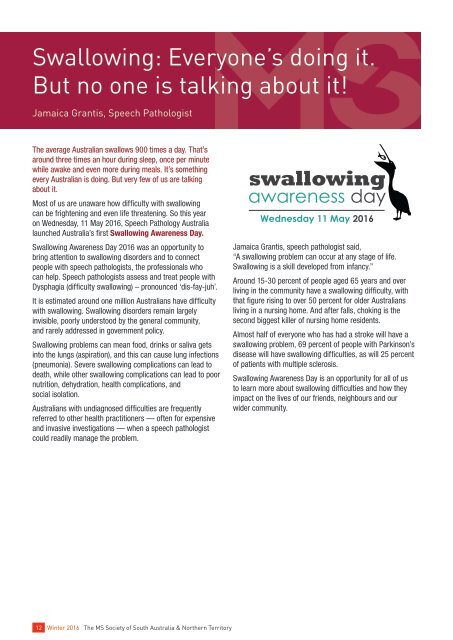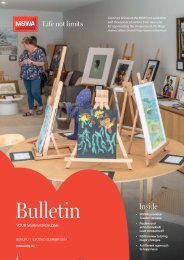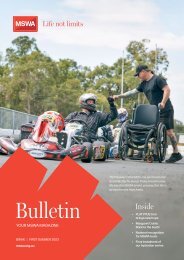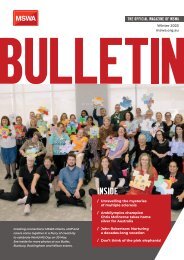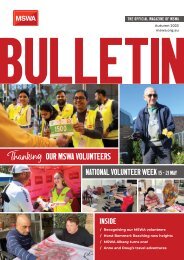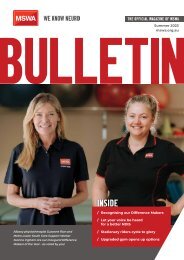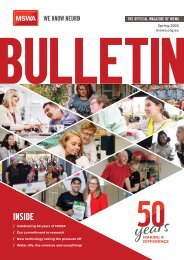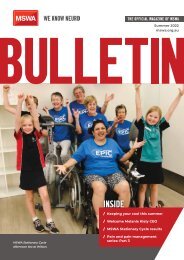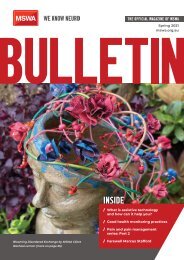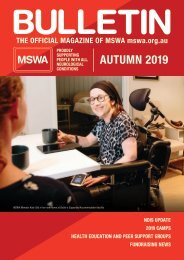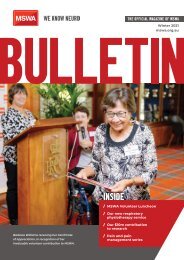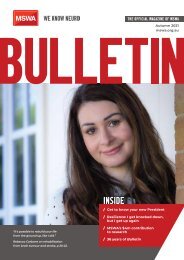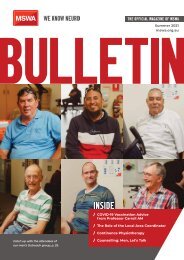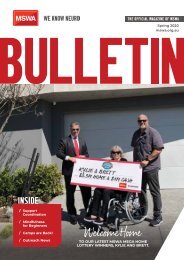MSSANT Network Magazine Winter 16
Create successful ePaper yourself
Turn your PDF publications into a flip-book with our unique Google optimized e-Paper software.
Swallowing: Everyone’s doing it.<br />
Swallowing Day<br />
But no one is talking about it!<br />
Jamaica Grantis, Speech Pathologist<br />
Campaign Kit<br />
Calcium,<br />
Vitamin D and MS<br />
Amber Rose, Volunteer & Student Dietitian<br />
The average Australian swallows 900 times a day. That’s<br />
around three times an hour during sleep, once per minute<br />
while awake and even more during meals. It’s something<br />
every Australian is doing. But very few of us are talking<br />
about it.<br />
Most of us are unaware how difficulty with swallowing<br />
can be frightening and even life threatening. So this year<br />
on Wednesday, 11 May 20<strong>16</strong>, Speech Pathology Australia<br />
launched Australia’s first Swallowing Awareness Day.<br />
Swallowing Awareness Day 20<strong>16</strong> was an opportunity to<br />
bring attention to swallowing disorders and to connect<br />
people with speech pathologists, the professionals who<br />
can help. Speech pathologists assess and treat people with<br />
Dysphagia (difficulty swallowing) – pronounced ‘dis-fay-juh’.<br />
It is estimated around one million Australians have difficulty<br />
with swallowing. Swallowing disorders remain largely<br />
invisible, poorly understood by the general community,<br />
and rarely addressed in government policy.<br />
Swallowing problems can mean food, drinks or saliva gets<br />
into the lungs (aspiration), and this can cause lung infections<br />
(pneumonia). Severe swallowing complications can lead to<br />
death, while other swallowing complications can lead to poor<br />
nutrition, dehydration, health complications, and<br />
social isolation.<br />
Australians with undiagnosed difficulties are frequently<br />
referred to other health practitioners — often for expensive<br />
and invasive investigations — when a speech pathologist<br />
could readily manage the problem.<br />
awareness day<br />
Wednesday 11 May 20<strong>16</strong><br />
Jamaica Grantis, speech pathologist said,<br />
“A swallowing problem can occur at any stage of life.<br />
Swallowing is a skill developed from infancy.”<br />
Around 15-30 percent of people aged 65 years and over<br />
living in the community have a swallowing difficulty, with<br />
that figure rising to over 50 percent for older Australians<br />
living in a nursing home. And after falls, choking is the<br />
second biggest killer of nursing home residents.<br />
Almost half of everyone who has had a stroke will have a<br />
swallowing problem, 69 percent of people with Parkinson’s<br />
disease will have swallowing difficulties, as will 25 percent<br />
of patients with multiple sclerosis.<br />
Swallowing Awareness Day is an opportunity for all of us<br />
to learn more about swallowing difficulties and how they<br />
impact on the lives of our friends, neighbours and our<br />
wider community.<br />
What is calcium?<br />
You probably already know that our bones and teeth are made<br />
of a mineral called calcium. But did you know that calcium<br />
is also classified as an earth metal? It’s pretty amazing to<br />
think that our skeletons are made of metal! Our bones, though<br />
we think of them as hard and rigid, are always turning over,<br />
reshaping and rebuilding as we grow older – from birth through<br />
to old age. This means that calcium is an essential nutrient for<br />
humans and we need to consume it in our daily diet<br />
(in the right amounts!) to keep ourselves in the best health.<br />
Why is it extra important to me?<br />
Not getting enough calcium can put you at risk of developing<br />
osteoporosis. Osteoporosis makes our bones weak and<br />
increases the risk of fractures and broken bones from falls.<br />
Unfortunately, people with MS are at increased risk of<br />
developing osteoporosis due to:<br />
• side effects from medications, which can affect the<br />
absorption of calcium;<br />
• being unable to be physically active due to fatigue and/or<br />
immobility, as our bones need to be subjected to regular<br />
weight-bearing activities every day to stay as strong as<br />
possible; and<br />
• needing to avoid heat and the sun, because vitamin D is<br />
also important for calcium absorption and bone health,<br />
and most of the vitamin D our body needs is made by the<br />
action of sunlight on our skin.<br />
What foods contain calcium?<br />
Dairy foods including milk, cheese and yoghurt are all good<br />
sources of calcium. Non-dairy sources of calcium include<br />
fish with edible bones such as tinned sardines and salmon,<br />
firm tofu, legumes, almonds, brazil nuts, fortified soy<br />
products, and leafy greens like broccoli, kale and bok choy.<br />
How much do I need?<br />
Osteoporosis Australia recommends that most people have three<br />
to five serves of calcium-rich foods per day in order to meet their<br />
body’s needs. Most people need 1,000 mg of calcium per day,<br />
which increases to 1,300 mg of calcium per day once you are<br />
over the age of 50. A serve of calcium-rich food could be:<br />
• One cup (250ml) of reduced fat milk = 520mg of calcium<br />
• Two slices (40g) of reduced fat cheese = 418mg of calcium<br />
• One tub (200g) of low-fat natural yoghurt = 488mg of calcium<br />
• Half a cup of firm tofu = 4<strong>16</strong> mg of calcium<br />
• Sardines canned in water, no added salt, drained = 486mg<br />
of calcium<br />
• One cup (250ml) of low fat fortified soy milk = 367mg<br />
of calcium<br />
If you think that you are not getting enough calcium through<br />
your diet alone, it is best to speak to your doctor about your<br />
concerns before taking supplements.<br />
Cooking with calcium - try it!<br />
Smoked Salmon, Rocket and Ricotta Linguine<br />
(Serves 4)<br />
• 250g linguine pasta or spaghetti<br />
• 250g Australian reduced-fat fresh ricotta, crumbled<br />
• 100g smoked salmon, torn into bite sized pieces<br />
• 100g rocket leaves<br />
• ½ cup basil leaves, roughly chopped<br />
• 2 spring onions, finely sliced<br />
• ½ teaspoon finely grated lemon rind<br />
• 2 tablespoons lemon juice<br />
• 2 teaspoons olive oil<br />
• Freshly ground black pepper, to taste<br />
• 1 /3 cup shaved Australian parmesan, for serving<br />
1. Cook linguine according to packet directions or until<br />
tender. Drain and return to pasta pot with a small amount<br />
of pasta water.<br />
2. Stir in ricotta, salmon, rocket, basil, spring onions, lemon<br />
rind and juice, oil and pepper.<br />
3. Divide between bowls and serve with shaved parmesan.<br />
Tip: You could add 300g of sliced smoked chicken in place<br />
of smoked salmon.<br />
Nutrients per Serve:<br />
Energy <strong>16</strong>14 kJ (386 calories) Protein 23g<br />
Total Fat 11.9g Saturated Fat 5.5g<br />
Carbohydrate 45g<br />
Sugars 2g<br />
Dietary Fibre 3g<br />
Sodium 647mg<br />
Calcium 297mg<br />
Iron 1mg<br />
Recipe Credit:<br />
Dairy Australia Good Health Recipe Book II (available online)<br />
Article Text Credits:<br />
Osteoporosis Australia<br />
Dietitians Association of Australia<br />
Croxton et al 2015. “Food and Nutrition Throughout Life”.<br />
Allen & Unwin: NSW, Australia.<br />
12 <strong>Winter</strong> 20<strong>16</strong> The MS Society of South Australia & Northern Territory The MS Society of South Australia & Northern Territory <strong>Winter</strong> 20<strong>16</strong> 13


